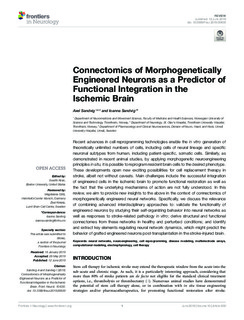| dc.contributor.author | Sandvig, Axel | |
| dc.contributor.author | Sandvig, Ioanna | |
| dc.date.accessioned | 2019-10-02T07:58:39Z | |
| dc.date.available | 2019-10-02T07:58:39Z | |
| dc.date.created | 2019-06-05T16:25:10Z | |
| dc.date.issued | 2019 | |
| dc.identifier.citation | Frontiers in Neurology. 2019, 10:630 1-13. | nb_NO |
| dc.identifier.issn | 1664-2295 | |
| dc.identifier.uri | http://hdl.handle.net/11250/2619766 | |
| dc.description.abstract | Recent advances in cell reprogramming technologies enable the in vitro generation of theoretically unlimited numbers of cells, including cells of neural lineage and specific neuronal subtypes from human, including patient-specific, somatic cells. Similarly, as demonstrated in recent animal studies, by applying morphogenetic neuroengineering principles in situ, it is possible to reprogram resident brain cells to the desired phenotype. These developments open new exciting possibilities for cell replacement therapy in stroke, albeit not without caveats. Main challenges include the successful integration of engineered cells in the ischemic brain to promote functional restoration as well as the fact that the underlying mechanisms of action are not fully understood. In this review, we aim to provide new insights to the above in the context of connectomics of morphogenetically engineered neural networks. Specifically, we discuss the relevance of combining advanced interdisciplinary approaches to: validate the functionality of engineered neurons by studying their self-organizing behavior into neural networks as well as responses to stroke-related pathology in vitro; derive structural and functional connectomes from these networks in healthy and perturbed conditions; and identify and extract key elements regulating neural network dynamics, which might predict the behavior of grafted engineered neurons post-transplantation in the stroke-injured brain. | nb_NO |
| dc.language.iso | eng | nb_NO |
| dc.publisher | Frontiers Media | nb_NO |
| dc.rights | Navngivelse 4.0 Internasjonal | * |
| dc.rights.uri | http://creativecommons.org/licenses/by/4.0/deed.no | * |
| dc.title | Connectomics of morphogenetically engineered neurons as a predictor of functional integration in the ischemic brain | nb_NO |
| dc.type | Journal article | nb_NO |
| dc.type | Peer reviewed | nb_NO |
| dc.description.version | publishedVersion | nb_NO |
| dc.source.pagenumber | 1-13 | nb_NO |
| dc.source.volume | 10:630 | nb_NO |
| dc.source.journal | Frontiers in Neurology | nb_NO |
| dc.identifier.doi | 10.3389/fneur.2019.00630 | |
| dc.identifier.cristin | 1703037 | |
| dc.relation.project | Samarbeidsorganet mellom Helse Midt-Norge og NTNU: x | nb_NO |
| dc.description.localcode | Copyright © 2019 Sandvig and Sandvig. This is an open-access article distributed under the terms of the Creative Commons Attribution License (CC BY). The use, distribution or reproduction in other forums is permitted, provided the original author(s) and the copyright owner(s) are credited and that the original publication in this journal is cited, in accordance with accepted academic practice. No use, distribution or reproduction is permitted which does not comply with these terms. | nb_NO |
| cristin.unitcode | 1920,0,0,0 | |
| cristin.unitcode | 194,65,30,0 | |
| cristin.unitname | St. Olavs Hospital HF | |
| cristin.unitname | Institutt for nevromedisin og bevegelsesvitenskap | |
| cristin.ispublished | true | |
| cristin.fulltext | original | |
| cristin.qualitycode | 1 | |

